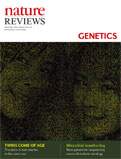|
Advertisement | |||||||||||||||||||||||||||||||||||||
| |||||||||||||||||||||||||||||||||||||
| TABLE OF CONTENTS | |||||||||||||||||||||||||||||||||||||
| September 2012 Volume 13 Number 9 | Advertisement | ||||||||||||||||||||||||||||||||||||
| In this issue
|
| |||||||||||||||||||||||||||||||||||
| |||||||||||||||||||||||||||||||||||||
 | |||||||||||||||||||||||||||||||||||||
| Advertisement | |||||||||||||||||||||||||||||||||||||
| |||||||||||||||||||||||||||||||||||||
| REVIEWS | Top | ||||||||||||||||||||||||||||||||||||
Transforming clinical microbiology with bacterial genome sequencing Xavier Didelot, Rory Bowden, Daniel J. Wilson, Tim E. A. Peto & Derrick W. Crook p601 | doi:10.1038/nrg3226 This Review sets out the emerging potential of next-generation sequencing in the context of clinical microbiology. Using bacterial genome sequencing as an example, the authors discuss the options and challenges for species identification, testing for virulence and drug resistance and monitoring outbreaks. Abstract | Full Text | PDF | |||||||||||||||||||||||||||||||||||||
Transcription factors: from enhancer binding to developmental control Francois Spitz & Eileen E. M. Furlong p613 | doi:10.1038/nrg3207 How do transcription factors lead to defined developmental programs? The ways in which transcription factors act at enhancer elements and how enhancer activity is established during development are discussed in this Review, which brings together genetic and genomic evidence. Abstract | Full Text | PDF | |||||||||||||||||||||||||||||||||||||
| The genetic basis of flowering responses to seasonal cues Fernando Andrés & George Coupland p627 | doi:10.1038/nrg3291 Seasonal cues, such as day length and temperature, influence the developmental programme of plants. Recent genetic research has shed light on the pathways that lead to seasonal responses in flowering. The regulation of these pathways in Arabidopsis thaliana, their conservation throughout other species and comparative analysis of annual and perennial plants are considered here. Abstract | Full Text | PDF | |||||||||||||||||||||||||||||||||||||
The continuing value of twin studies in the omics era Jenny van Dongen, P. Eline Slagboom, Harmen H. M. Draisma, Nicholas G. Martin & Dorret I. Boomsma p640 | doi:10.1038/nrg3243 Twin studies have long been used for dissecting the relative contributions of genetics and other factors to various phenotypes. This Review discusses how these traditional studies are now being integrated with modern omics technologies to provide a wide range of biological insights. Abstract | Full Text | PDF | Supplementary information | |||||||||||||||||||||||||||||||||||||
| The Notch signalling system: recent insights into the complexity of a conserved pathway K. G. Guruharsha, Mark W. Kankel & Spyros Artavanis-Tsakonas p654 | doi:10.1038/nrg3272 The Notch signalling network is highly conserved in Metazoa and is crucial for various cell-fate decisions. Focusing on Drosophila melanogaster, this Review summarizes and integrates various recent studies, including large-scale genetic and proteomic screens that have provided a new appreciation of the complexity of Notch signalling. Abstract | Full Text | PDF | Supplementary information | |||||||||||||||||||||||||||||||||||||
| PERSPECTIVES | Top | ||||||||||||||||||||||||||||||||||||
| OPINION Next-generation sequencing data interpretation: enhancing reproducibility and accessibility Anton Nekrutenko & James Taylor p667 | doi:10.1038/nrg3305 There are many different methods and tools available for the analysis of next-generation sequencing data. The challenges towards applying these analysis tools in a transparent and reproducible manner are presented, and a way forward for analysing these data in life sciences research is discussed. Abstract | Full Text | PDF | Supplementary information | |||||||||||||||||||||||||||||||||||||
| Corrigendum: Genetics of osteoporosis from genome-wide association studies: advances and challenges J. Brent Richards, Hou-Feng Zheng & Tim D. Spector p672 | doi:10.1038/nrg3315 Full Text | PDF | |||||||||||||||||||||||||||||||||||||
| Advertisement | |||||||||||||||||||||||||||||||||||||
| |||||||||||||||||||||||||||||||||||||
| |||||||||||||||||||||||||||||||||||||
| *2011 Journal Citation Report (Thomson Reuters, 2012) |
You have been sent this Table of Contents Alert because you have opted in to receive it. You can change or discontinue your e-mail alerts at any time, by modifying your preferences on your nature.com account at: www.nature.com/myaccount For further technical assistance, please contact our registration department For print subscription enquiries, please contact our subscription department For other enquiries, please contact our feedback department Nature Publishing Group | 75 Varick Street, 9th Floor | New York | NY 10013-1917 | USA Nature Publishing Group's worldwide offices: Macmillan Publishers Limited is a company incorporated in England and Wales under company number 785998 and whose registered office is located at Brunel Road, Houndmills, Basingstoke, Hampshire RG21 6XS. © 2012 Nature Publishing Group, a division of Macmillan Publishers Limited. All Rights Reserved. |
 |






No comments:
Post a Comment